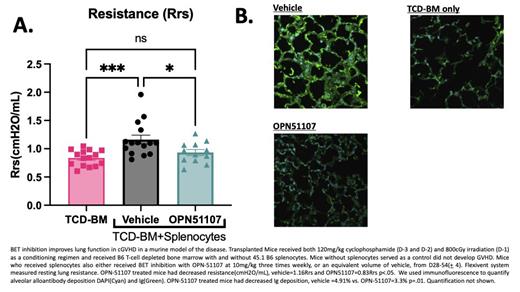Introduction:
Chronic graft-versus-host disease (cGVHD) is a severe complication of allogeneic hematopoietic cell transplant (allo-HCT) often leading to transplant-mediated mortality. Studies have shown that T follicular helper cells (Tfh) upregulate CXCR5 and migrate into the lymphoid organ follicles in response to CXCL13 promoting germinal center (GC) B cell proliferation and differentiation of plasma cells resulting in pathogenic antibody production and profibrotic pathways associated with cGVHD. In contrast, T follicular regulatory cells (Tfr) modulate the magnitude of the GC response; thus, the balance of Tfr/Tfh could be crucial to mitigating cGVHD.Bromodomain and extra-terminal domain (BET) proteins are epigenetic readers influencing transcription of a multitude of inflammatory genes and our lab has previously reported pharmacological inhibition of BET, through OPN-51107, improves survivability and limits disease progression in murine models of acute GVHD that led to opening the first-in-human clinical trial of OPN-51107 in steroid refractory acute GVHD. We demonstrated BET proteins to be important in modulating acute GVHD pathogenesis, however, mechanisms of BET regulation within cGVHD are largely unknown. Here, using OPN-51107 we aim to further investigate mechanisms of cGVHD pathogenesis and identify successful BET inhibition-based therapeutic approaches.
Methods:
We used a Bronchiolitis Obliterans model (B6->B10.br) of cGVHD. Mice were administered 120mg/kg cyclophosphamide (D-3 and D-2) and 8Gy irradiation (D-1) as a conditioning regimen followed by B6 T-cell depleted bone marrow cells with and without CD45.1 B6 splenocytes. Mice that did not receive allogeneic splenocytes served as controls and did not develop GVHD. Recipients of allogeneic splenocytes were treated with a BET inhibitor - OPN-51107 at 10mg/kg 3x/weekly, or vehicle, from D28-54(+ 4) via oral gavage. Resting lung elastance and resistance was measured using the Flexivent system. At the time of lung function analysis, lung and liver tissue was harvested and stained via Hesson's Trichrome to identify and quantify collagen deposition. We performed immunofluorescence to quantify alveolar alloantibody deposition. Spleen and lung cells were stimulated with PMA/I and analyzed via spectral flow cytometry. An inflammatory murine cytokine array (#ARY006, R&D Systems) was used to analyze circulating plasma cytokine levels.
Results:
BET inhibition via OPN-51107 treatment decreased lung resistance (vehicle vs OPN-51107 =1.16Rrs vs 0.83Rrs p<0.05) and elastance (vehicle vs. OPN-51107=62Ers vs. 45Ers p<0.05). OPN-51107 treatment also significantly reduced alveolar antibody (Ig) deposition per area compared to vehicle (vehicle vs. OPN-51107= 4.91% vs. 3.3% p=0.01) and collagen deposition (vehicle vs. OPN-51107=19.0% vs. 12.9% p<0.05) and liver (vehicle vs. OPN-51107=19.3% vs. 2.35% p<0.0001).
Congruently, BET inhibition decreased B220-CD19- CD138+mature plasma cells (vehicle vs. OPN-51107=15% vs 9.1% p<0.05) in the lung. Serum cytokine array analysis revealed a significant decrease in circulating CXCL13, relevant to Tfh migration as well as a decrease in other proinflammatory cytokines - CXCL9, MCP-1, IL3, RANTES and G-CSF important for macrophage activation and pathogenicity in OPN-51107 compared to vehicle treated mice. BET inhibition reduced splenic Tfh while increasing Tfr, thereby increasing Tfr:Tfh ratio (vehicle vs. OPN-51107= 5% vs. 9% p<0.05). Furthermore, total splenic CD19+ B-cells (vehicle vs. OPN51107= 70% vs. 33% p<0.001) as well as CXCR5 expression on B-cells were decreased in OPN-51107 treated mice (MFI vehicle vs. OPN-51107= 4744 vs. 571.5 p<0.0001).
Conclusion:
OPN-51107 improved lung function which correlated with significantly decreased lung fibrosis and antibody deposition in a BO model of cGVHD. BET inhibition reduces cGVHD immune pathology through decreased inflammatory cytokine production, promotion of GC Tfr cell population and modulates B-cell proliferation and/or trafficking.
Significance:
Using OPN-51107 in a BO model of cGVHD we demonstrate that BET inhibition is a feasible therapeutic strategy to reduce disease severity and improve lung function.
Disclosures
Bollag:Opna Bio, LLC: Current Employment, Current equity holder in private company, Current holder of stock options in a privately-held company, Membership on an entity's Board of Directors or advisory committees, Patents & Royalties; Plexxikon Inc.: Ended employment in the past 24 months, Membership on an entity's Board of Directors or advisory committees, Patents & Royalties. Powell:Plexxikon Inc.: Ended employment in the past 24 months, Membership on an entity's Board of Directors or advisory committees, Patents & Royalties; Opna Bio, LLC: Current Employment, Current equity holder in private company, Current holder of stock options in a privately-held company, Membership on an entity's Board of Directors or advisory committees, Patents & Royalties. Choe:Opna: Other: Receipt of equipment, materials, drugs to institution, Research Funding; Incyte: Consultancy, Membership on an entity's Board of Directors or advisory committees, Other: Receipt of equipment, materials, drugs to institution; MJH Life Sciences: Honoraria; Actinium Pharmaceuticals: Other: Support for attending meetings and/or travel; NIH National Cancer Institute: Research Funding.


This feature is available to Subscribers Only
Sign In or Create an Account Close Modal